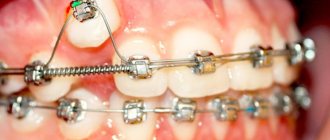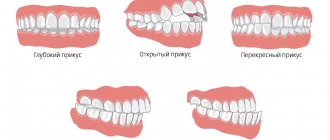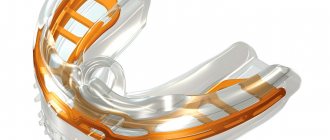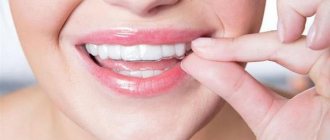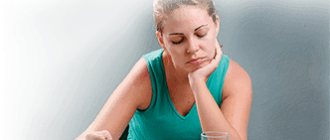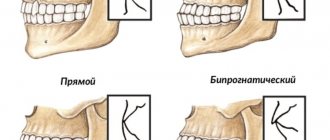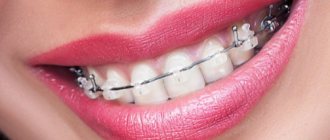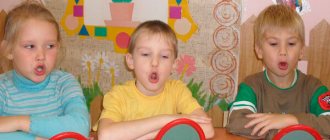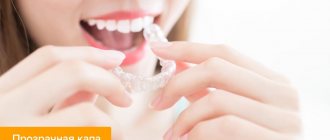Full health of a dog means the good condition of all its organs and systems, including teeth. Unfortunately, these friendly animals, which have served man faithfully for a long time, have not been spared many “human” diseases. One of them is an incorrect bite in a dog.
For breeding puppies or service breed dogs, this disease becomes a death sentence, excluding the right to serve or breed. In addition, this deficiency greatly affects the dog’s overall health.
What is orthodontics?
A young area in veterinary practice, but steadily developing and in demand. A veterinary orthodontist (dentist) corrects existing dental anomalies or prevents possible ones by monitoring the dog from puppyhood. Our veterinary clinic has created a dental department, which contains all the options for specific devices (braces) for correcting bites in dogs of different ages, breeds and sizes.
It is important to understand! The sooner the dog owner brings his pet for a consultation with a dentist (orthodontist), the higher the likelihood of correcting the bite correctly and achieving the desired results in a short time. In older animals, the jaw bones become denser and remodeling occurs much more slowly.
Bite correction: which age is best?
Puppies are born toothless! The incisors appear first, by about a month, followed by the canines and the last premolars (5-6 weeks). There are fewer “children’s” teeth, only 28; after changing permanent teeth at 4-6 months, there are 42. They are larger, the enamel is yellower and stronger.
The following are considered abnormal in quantity:
- oligodontia (incomplete set of permanent teeth);
- polio- or hyperdontia.
The last two concepts refer to the presence of extra teeth. According to the norm, by 7 months the dog’s teeth should completely change and premolars and molars, for which there are no milk predecessors, should grow.
Etiological factors and responsibility
Breeders do not always realize that when purchasing a puppy with malocclusion, they take on additional responsibility for the maintenance and treatment of such a pet. Crooked teeth injure the gums, tongue, cheeks, and lips of dogs. Such animals are discarded and are not bred! This is explained by a genetically inherited pathology - malocclusion is passed on to puppies from their parents, so they are not allowed at exhibitions.
As etiological factors (reasons), specialists of the RosVet VC consider:
- heredity;
- improper games or training. The breeder tugs too hard on a toy, rope or stick, practically ripping it out of the mouth or encouraging the puppy to hang on it;
- irrational, unbalanced diet, causing a lack of calcium, fluoride, etc.;
- discrepancy between the number and size of teeth and jaw;
- traumatization;
- delayed change of teeth or eruption of permanent teeth when milk teeth have not fallen out.
The latter is false polyodontia, which is often diagnosed in toy terriers. The reason for this is the poor development of the chewing muscles, insufficient resorption of the roots of baby teeth and errors in nutrition, when owners give soft food with a low calcium content.
Malocclusion: description of defects
A veterinary orthodontist at the RosVet VC describes the following types of malocclusion in dogs, which are often encountered in practice. This:
- prognathia (underbite), in other words, a visually shortened lower jaw, its poor development, when the lower incisors do not reach the upper ones. When the mouth is closed, a significant gap is formed between the upper and lower incisors. Normally this should not happen! Such dogs are discarded at the exhibition and are not allowed for breeding;
- progenia (overbite) or excessive protrusion of the lower jaw forward, and the lower incisors protrude above the upper ones. Normally, a reverse scissor bite occurs in Shih Tzus, bulldogs, and boxers.
“Direct bite” is the most uncomfortable, the upper and lower incisors touch each other, the teeth grind down faster and incorrectly.
There is an acquired malocclusion - “anterior crossbite”, when several lower incisors protrude above the upper ones, but the remaining teeth are normal. It is formed if the owner often plays tug of war with the puppy.
A crooked bite is a genetically inherited severe defect when one part of the jaw grows faster than the opposite. In this case, the lower canines tilt inward and damage the palate. Often the same defect occurs with false polyodontia or with a very narrow jaw.
Open bite - the incisors are spaced vertically and stand without touching each other. A distinctive feature is the tongue hanging outward, and after a detailed examination (X-ray), impacted teeth remaining in the jaw are discovered.
Is it necessary to “take out” unerupted teeth from the thickness of the jaw? Yes, if they put pressure on neighboring ones, promoting their migration and resorption, they cause pain. If deep-lying teeth do not cause problems for the dog, eating and chewing food is normal - they are left in place, periodically observing them.
Face lift
Let's look at several options for procedures for correcting the lower third of the face and eliminating asymmetry.
Lipolitics
The procedure for modeling the face using lipolytics is called injection lipolysis. Lipolitics are preparations based on natural ingredients, their main action is aimed at the breakdown of subcutaneous fat cells, resulting in a rejuvenating effect.
The effect of the procedure with lipolytics occurs quite quickly, the oval of the face changes, and the subcutaneous tissue structure is aligned. The procedure does not allow the splitting of an extensive layer of fat.
In what cases are lipolytics used?
- if you need to eliminate a double chin,
- form a natural oval face,
- reduce the volume of the cheeks,
- eliminate defects in the shape of the nose,
- correct nasolabial folds
Cost per 1 ml
procedures vary
from 3 thousand rubles
and more, depending on the drug, the number of milliliters administered and the number of correction zones. For a pronounced effect, you need at least six to eight procedures for each zone, which involves serious expenses, reaching 200 thousand rubles and even higher.
The lifting effect is temporary. After some time, the procedure is usually repeated.
Mesotherapy
Mesotherapy consists of therapeutic injections of individually selected cocktails, which are injected into the middle layer of the skin with a very thin needle.
After the mesotherapy procedure:
- complexion improves,
- muscle tone increases,
- you can eliminate “creases” in the skin,
- you can remove nasolabial folds and drooping corners of the lips,
- You can remove your double chin.
The number of rejuvenating procedures during mesotherapy depends on the age and problems that need to be eliminated. Mesotherapy has a cumulative effect, the results of the procedures can be seen in 2-4 weeks. On average, 5 to 7 procedures are required with an interval of 1 time per week; if necessary, the cosmetologist can increase the number of mesotherapy procedures. The cost of the procedure varies from 4000 - 5000 rubles
and higher in one procedure.
Mesotherapy effect
- temporary. To maintain the effect, the procedure must be repeated once every 6-12 months.
Biorevitalization - 3D face lifting with hyaluronic acid
The biorevitalization procedure is currently the most popular. We all know well, according to doctors, that the main property of hyaluronic acid is to retain moisture, maintaining the natural hydrobalance of the skin.
Biorevitalization is carried out in all areas where there are problems - on the face, neck, décolleté, and is also used in other areas of the body, providing the necessary hydro reserve to the skin layers. Injection biorevitalization is comparable in effect to a surgical facelift; the procedure can completely sculpt the face.
Using hyaluronic acid injections, you can correct the lower third of the face:
- remove pronounced nasolabial folds,
- remove flaws, if any, on the chin, that is, change its shape,
- and also adjust the profile along the lower jaw.
Cost of biorevitalization.
The cost of injections depends on the drug used, its density and the number of milliliters required for the procedure. For example, for visual correction of malocclusion (the area under the chin), you may need up to 4 ml of the drug, the cost of 1 ml is from 18-20 thousand rubles. The general course can range from 1 to 5 procedures at intervals.
The effect of biorevitalization
- temporary. After the procedure, there is an immediate, pronounced visual effect that lasts from 5 to 12-15 months; to maintain the effect, the procedure must be repeated.
Kogi threads
Cog mesothreads provide a clear oval face and a pronounced lifting effect. Installed mesothreads contribute to the formation of dense connective tissue, and also help to activate the production of collagen and elastin, which are responsible for skin elasticity.
Kogi threads have notches, thanks to which it is possible to achieve:
- pronounced lifting effect,
- clear contour, tightening of soft tissues and prolonged action of thread lifting,
- They perfectly hold the given shape of problem areas of the face or body.
You may need 4-6 threads for the whole face, the average price is from 5 - 15 thousand rubles for 1 thread.
Effect of the procedure
- longer lasting, but also temporary. Kogi threads have a prolonged effect, the result of the procedure lasts from 2 to 4 years, to maintain the effect the procedure must be repeated.
How malocclusion in dogs is corrected at the RosVet Exhibition Center
The specialists at the RosVet veterinary clinic have in their arsenal the most modern types of devices that are used to correct bites. Conventionally, they are divided into braces, or fixed and removable structures.
"The squeak of fashion"
Invisible braces are most in demand among dog owners; they are the rage in veterinary orthodontics. They are transparent, removable mouthguards that are made from an impression of the dog’s jaw. A special advantage is the ability to remove them while eating or for cleaning/sterilization.
Acrylic invisible trays, adjacent to the teeth, put pressure on them, “forcing” them to grow in the desired direction. Once every 1-2 weeks they are replaced with new ones made to different sizes. This technology allows you to straighten your bite due to the fact that the teeth gradually correct their position.
The advantage of such mouthguards is that they are unobtrusive; the dog does not wear them all the time, but for several hours a day. But in veterinary practice they are little used due to the high cost of this technology for correcting the bite.
Braces for dogs
Braces, or staples, are complex devices made of wires and “clasps” that are secured to the teeth. Fastened at a certain angle and having different thicknesses of wire, braces exert varied pressure on crooked teeth, which are gradually returned to their normal position. The thicker the wire, the stronger the pressing force.
Elimination methods
No matter the age of the animal, you cannot solve the problem yourself. The anomaly can be corrected before the animal reaches 5-12 months of age.
Important! Only a veterinarian will correctly decide how to correct the defect and determine the treatment method. The owner’s task is to strictly follow the specialist’s instructions.
For puppies, this may include increased nutrition with the inclusion of various vitamin supplements. There may be special massages and exercises to develop certain muscles and bones.
Dogs get braces. They come in 2 types. Removable – silicone. Installed on the incisors for constant, uniform pressure on the teeth. They are tightened as necessary.
Fixed - a system of pins or plates. As the teeth grow, it is tightened. For adults - surgery. In any case, the doctor decides what and how to do.
Before you decide to have your pet's teeth adjusted, you should decide how necessary it is.
What should a dog owner with an overbite know?
The use of braces on dogs requires constant supervision by the breeder. It is necessary to properly care for structures, prevent mechanical damage, and clean them. You need to play carefully with a dog that has braces; do not give bones or very hard food, as the braces may break.
You cannot install braces if you have stomatitis, allergy to alloy, periodontitis, ulcerative stomatitis and neoplasms in the oral cavity.
A positive prognosis for correcting malocclusion depends on an adequate diagnosis and the choice of the optimal treatment method. And this is only possible in a modern veterinary clinic with a fully equipped dental office - such as in the RosVet VC!
If your dog has an incorrect bite, has problems with grasping and chewing food, or the pet does not look aesthetically pleasing due to dental problems - do not hesitate! Call the RosVet VC by phone, 24 hours a day, and make an appointment for your dog with an orthodontist.
Prevention
Malocclusion is not always a congenital genetic feature. In most cases, simple preventive measures will help avoid this defect. We will talk about these measures further.
First of all, you need to pay attention to the proper nutrition of your pet. It is important to ensure that his diet contains enough calcium, vitamin D3 and other important microelements. Dry food must be selected strictly according to the age category of the animal. If you feed your puppy natural food, take care of additional vitamin and mineral supplements.
Bring your dog to the veterinarian regularly. This issue should be given particular importance when baby teeth are replaced by molars. During this period, the bite is often disturbed due to captive baby teeth: therefore, if necessary, the latter are removed. Sometimes the dog's chewing of hard toys and objects can help the rapid loss of baby teeth.
If your puppy has started to develop an incorrect bite, a rubber ring installed by a veterinarian will help correct the situation at an early stage. It is only important not to let the situation take its course, and take measures to correct the problem as early as possible.
Attention : all preventive measures should be taken when the dog is still a puppy: the earlier, the better.
So, we have learned what a correct bite in dogs is, and how such a defect can be eliminated. As you can see, the incorrect position of the teeth has a negative impact not only on the dog’s appearance, but is also harmful to its health. Pay attention to the position of your pet’s teeth, and be sure to contact a competent veterinarian in a timely manner if there is a need to correct the bite.
Currently reading:
- Thyroid dysfunction in dogs (hypothyroidism)
- Seven Signs and Remedies for Getting Rid of Fleas in Dogs
- How to recognize signs of dog poisoning from rat poisons
- Features of the character and upbringing of the Australian Shepherd

